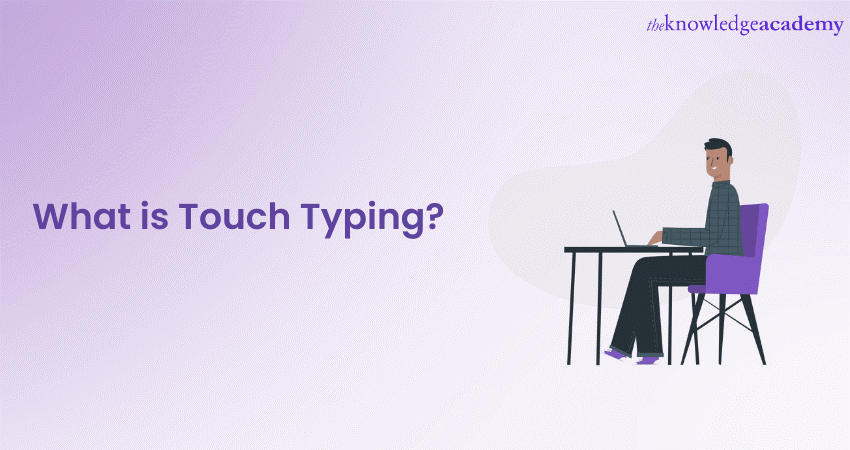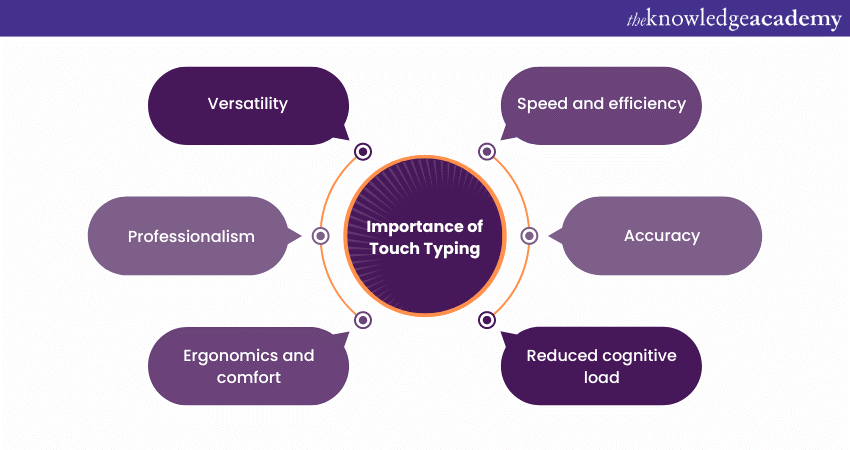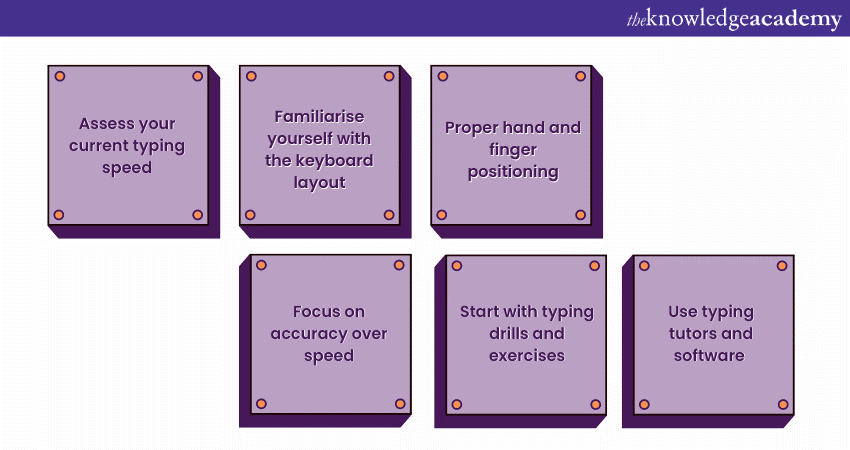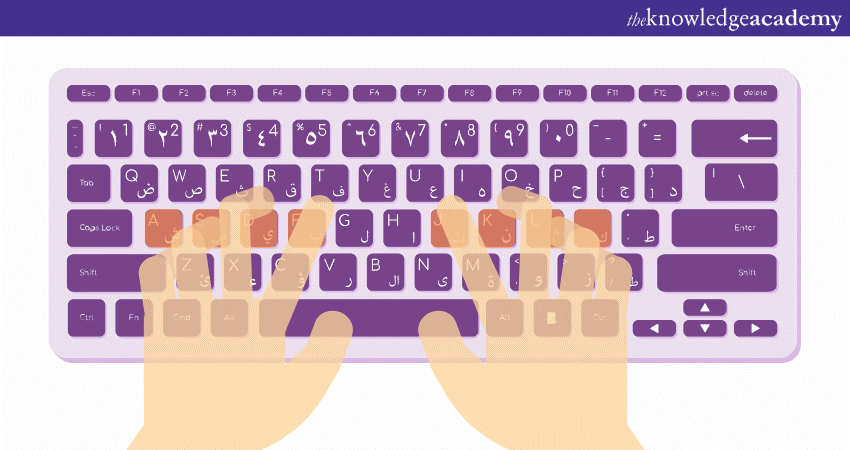We may not have the course you’re looking for. If you enquire or give us a call on +852 2592 5349 and speak to our training experts, we may still be able to help with your training requirements.
Training Outcomes Within Your Budget!
We ensure quality, budget-alignment, and timely delivery by our expert instructors.

Are you tired of hunting and pecking at your keyboard, struggling to keep up with your thoughts as you type? If so, it's time to learn What is Touch Typing. It is a skill that allows you to type quickly without looking at the keyboard.
Touch Typing is not just about typing quickly but also accurately, without needing to look at the keyboard. It's a skill that can boost your productivity, save you time, and make you a more efficient communicator in your professional era. There's more to this skill that remains unravelled. Read this blog to learn about What is Touch Typing, and explore its importance, steps to get started, and useful tips to master the skill.
Table of Contents
1) What is Touch Typing?
2) Why is Touch Typing important?
3) How to get started with Touch Typing?
4) Tips to master Touch Typing
5) Conclusion
What is Touch Typing?
Today, typing has become an essential skill for both personal and professional use. From writing an email to working on a school assignment to just chatting with friends, typing efficiently can save you a lot of time and frustration. One of the most effective ways to master this skill is through Touch Typing.
Unlock your typing potential with our Touch Typing Training - Register now and master touch typing for improved productivity!
Why is Touch Typing Important?
After learning What is Touch Typing, it’s time to learn about its importance. Here are some compelling reasons why Touch Typing is important:

Speed and efficiency
Touch Typing allows you to type much faster and more efficiently than the hunt-and-peck method. With practice, Touch Typists can achieve typing speeds of 50 Words Per Minute (WPM) or more, compared to the significantly slower speeds of those who use the two-fingered approach. This increased speed is very important for anyone who needs to create documents, write emails, or perform data entry tasks regularly. It means you can complete tasks more quickly, freeing up time for other important activities.
Your workflow becomes smoother when you can type without looking at the keyboard. You can focus entirely on the content you're creating or the task at hand rather than constantly glancing down at the keys.
Accuracy
Touch Typing promotes accuracy. When you're not constantly glancing at the keyboard to find the right keys, you reduce the chances of making typing errors. This is especially crucial in professional settings where precision is essential, such as legal documents, medical records, or coding. Fewer errors mean less time spent proofreading and correcting, leading to higher-quality work.
Reduced cognitive load
Touch Typing frees your mind from the cognitive burden of searching for keys and deciding which fingers to use. Instead, your fingers automatically find the correct keys through muscle memory, allowing you to focus entirely on the content you're typing. This enhanced mental focus is especially beneficial for tasks that require creativity or problem-solving.
Ergonomics and comfort
Proper Touch Typing technique promotes better ergonomics and comfort while typing. When your hands are correctly positioned on the keyboard, you minimise the risk of developing Repetitive Strain Injuries (RSIs) such as Tendonitis. Maintaining a neutral wrist position and using all ten fingers can significantly lower the physical stress on your hands and wrists during prolonged typing sessions.
Professionalism
In the majority of professions, the ability to type quickly and accurately is considered a basic skill. Whether you're a Writer, an Administrative Assistant, a Programmer, or a Journalist, employers often expect a certain level of typing proficiency. Being a Touch Typist not only meets these expectations but also reflects professionalism and competence in your field.
Versatility
Once you've mastered Touch Typing, you'll find it easier to adapt to different keyboard layouts and devices, making you a more versatile typist. Whether you're using a laptop, desktop computer, or even a smartphone, your Touch Typing skills will serve you well.
Elevate your communication skills with our comprehensive Shorthand Training – Sign up now to write faster and more efficiently!
How to get started with Touch Typing?
Now that we understand the Touch Typing meaning and its importance let's delve into how you can get started. Getting started with Touch Typing is a pivotal step toward improving your typing speed and accuracy. Here's an in-depth guide on how to begin your Touch Typing journey:

1) Assess your current typing speed
Before diving into Touch Typing, it's crucial to gauge your starting point. You can find various online typing tests and software that will measure your current typing speed and accuracy. Knowing where you stand initially will help you track your progress as you improve.
2) Familiarise yourself with the keyboard layout
The first step in Touch Typing is to become intimately familiar with the keyboard layout. The standard keyboard layout used in most English-speaking countries is known as the QWERTY layout. Spend some time studying the layout and memorising the positions of each key. You can find keyboard diagrams online to assist with this.
3) Proper hand and finger positioning
The foundation of Touch Typing is the correct hand and finger positioning. Here's how to position your hands and fingers correctly:

a) Home row: Place your fingers on the home row keys, where your left-hand fingers rest on the A, S, D, and F keys, and your right-hand fingers rest on the J, K, L, and ;(semicolon) keys. The thumbs are usually used for the spacebar.
b) Finger assignments: Assign specific fingers to specific keys. For example, your left pinky should be responsible for the A key, your left ring finger for the S key, your left middle finger for the D key, and your left index finger for the F key. Similarly, your right pinky handles the (semicolon) key, your right ring finger the L key, your right middle finger the K key, and your right index finger the J key. Thumbs manage the spacebar.
c) Typing posture: Sit up straight with your feet flat on the ground. Keep your wrists in a neutral position, and avoid resting them on the keyboard or desk. This posture reduces strain on your wrists and promotes a more ergonomic typing experience.
4) Focus on accuracy over speed
In the early stages of Touch Typing, it's more important to focus on accuracy rather than speed. Resist the temptation to rush through typing exercises, as this can lead to the development of bad habits and decreased accuracy. Speed will naturally improve as your muscle memory strengthens.
5) Start with typing drills and exercises
To begin practising Touch Typing, start with typing drills and exercises designed to familiarise your fingers with the keyboard layout. You can find numerous resources and websites offering free typing lessons and exercises. These drills typically start with the home row keys and gradually introduce new keys as you progress.
6) Use typing tutors and software
Consider using typing tutor software or online typing courses designed to guide you through the learning process. These programs often include structured lessons, interactive exercises, and progress tracking. Some popular typing tutor programs include TypingClub, Keybr, and 10FastFingers.
Tips to master Touch Typing
While learning What is Touch Typing, mastering its techniques requires more than just practising the basics. To become a proficient Touch Typist, consider implementing the following tips:
1) Avoid looking at the keyboard: Resist the temptation to look at the keyboard while typing. This might be challenging initially, but it's crucial for developing your muscle memory.
2) Be patient and persistent: Becoming an expert at Touch Typing takes time. So, be patient with yourself, and keep practising regularly. Progress may be slow at first, but it will pick up as you become more comfortable.
3) Practice with real content: Rather than relying solely on typing exercises, practice Touch Typing with real content. Transcribe articles, type out your notes, or draft emails. This will help you apply your Touch Typing skills to practical tasks.
4) Minimise distractions: Create a distraction-free environment when practising Touch Typing. This will help you to focus entirely on building your skills.
5) Take breaks: Avoid long typing sessions without breaks. Short, regular breaks can help prevent fatigue and maintain your typing accuracy.
6) Consider using keyboard shortcuts: In addition to Touch Typing, learn and use keyboard shortcuts for various tasks. This will further enhance your overall efficiency when working on a computer.
Conclusion
We hope this blog answers your questions about What is Touch Typing, and how to do it. Start your journey today, and with consistent practice and the right resources, you'll soon find yourself typing quickly and accurately without ever glancing at the keyboard. While becoming a proficient Touch Typist may take time and dedication, the benefits are well worth the effort.
Master the art of Teeline Shorthand with our specialised Teeline Shorthand Masterclass – Take your note-taking skills to the next level!
Frequently Asked Questions
Upcoming Business Skills Resources Batches & Dates
Date
 Minute Taking Training
Minute Taking Training
Fri 15th Nov 2024
Fri 17th Jan 2025
Fri 7th Mar 2025
Fri 23rd May 2025
Fri 18th Jul 2025
Fri 12th Sep 2025
Fri 14th Nov 2025
Fri 12th Dec 2025







 Top Rated Course
Top Rated Course



 If you wish to make any changes to your course, please
If you wish to make any changes to your course, please


